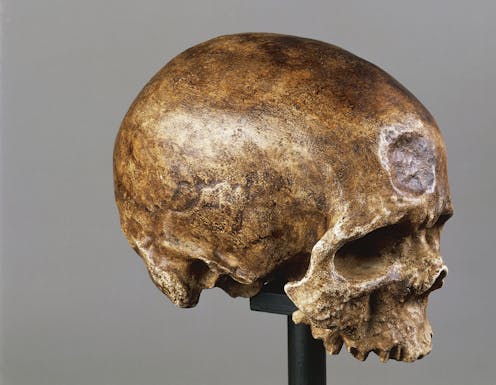How did humans evolve, and will they evolve more?
Our biggest evolutionary advantages are an ability to walk on two legs and our big brains.


Curious Kids is a series for children of all ages. If you have a question you’d like an expert to answer, send it to curiouskidsus@theconversation.com.
How did humans evolve, and will they evolve more? – Anya T., 13, Brookline, Massachusetts
Everything that is alive today has evolved, including human beings.
Our ancestors evolved many traits that helped them survive in their environments, and we still have many of those traits today. Two of the most important and consequential traits are walking on two legs and having a large brain.
I’m a scholar of human evolution. I study how evolution works, including how it has changed the shape of the bones in the skull and ankle of humans and other primates.
So how did humans evolve, and where will evolution take us in the future?
What evolution is
People pass traits to their children through genes. We can have different versions of the same genes – called alleles – and evolution occurs when the proportion of these alleles in the population changes over multiple generations.
Alleles in a population often help certain individuals survive in their own environment. This means that evolution isn’t about becoming the fastest, or the strongest, or the smartest, because it all depends on the environment.
Early ancestors of humans evolved to walk upright on two legs around 6 million years ago.
Scientists are still trying to figure out why our ancestors started walking on two legs. Today, the most common hypothesis is that walking on two legs probably helped our ancestors to move between forest patches that were shrinking due to a changing climate.
What about our brains?
Relative to the size of our bodies, humans have the largest brains on the planet. Elephants have bigger brains, but their bodies are even bigger than ours.
Without big brains we wouldn’t be able to innovate, such as by creating an alphabet, sending machines to Mars or creating vaccines that protect us against measles and other dangerous diseases. Our big brains make it possible to share information culturally through books, storytelling or even movies, rather than only passing our genes to the next generation.
Our ancestors’ brains got bigger over the course of human evolution until about 200,000 to 300,000 years ago when modern humans, known as Homo sapiens, showed up.
After that, human brains actually started to get a bit smaller, possibly because our bodies have gotten smaller or perhaps because a slightly smaller brain may not use as much energy.
Humans are still evolving. For example, because they have a largely vegetarian diet like their ancestors did, many people who live in the city of Pune, India, have a mutation that helps them more efficiently process omega-3 and omega-6 fatty acids. Vegetarians can have trouble getting enough of those nutrients, which are important for having a healthy brain.
Humans in the future
Nobody knows where human evolution will lead.
All organisms, including humans, adapt to their environments. And those environments can change – sometimes in entirely unpredictable ways.
It may disappoint you to hear that people aren’t likely to evolve superpowers like those in the “X-Men” movies or characters in the Marvel Cinematic Universe, at least for the most part.
However, there is one Marvel character humans have evolved to be like: Iron Man.
Like Iron Man, humans are smart enough to invent things that can make some of us live longer or have more fun, whether it’s a device that keeps an ailing heart beating or an airplane that makes it possible to fly without wings.
It’s unlikely that humans will ever evolve laser beam eyes or wings out of our backs like the X-Men characters Cyclops and Archangel. But other abilities that humans have evolved over millions of years of evolution allow us to do many of those same things, through innovation.
Hello, curious kids! Do you have a question you’d like an expert to answer? Ask an adult to send your question to CuriousKidsUS@theconversation.com. Please tell us your name, age and the city where you live.
And since curiosity has no age limit – adults, let us know what you’re wondering, too. We won’t be able to answer every question, but we will do our best.
Evan Simons receives funding from the National Science Foundation.
Read These Next
Can scientists detect life without knowing what it looks like? Research using machine learning offer
A new machine learning model explores the boundary between biological and nonbiological chemistry.
Sharks and rays get a major win with new international trade limits for 70+ species
Sharks have had a tough time since the 1970s, when overfishing, habitat loss and a growing trade in…
Songbirds swap colorful plumage genes across species lines among their evolutionary neighbors
Interbreeding across species lines is one way helpful genes can spread into a bird population.





